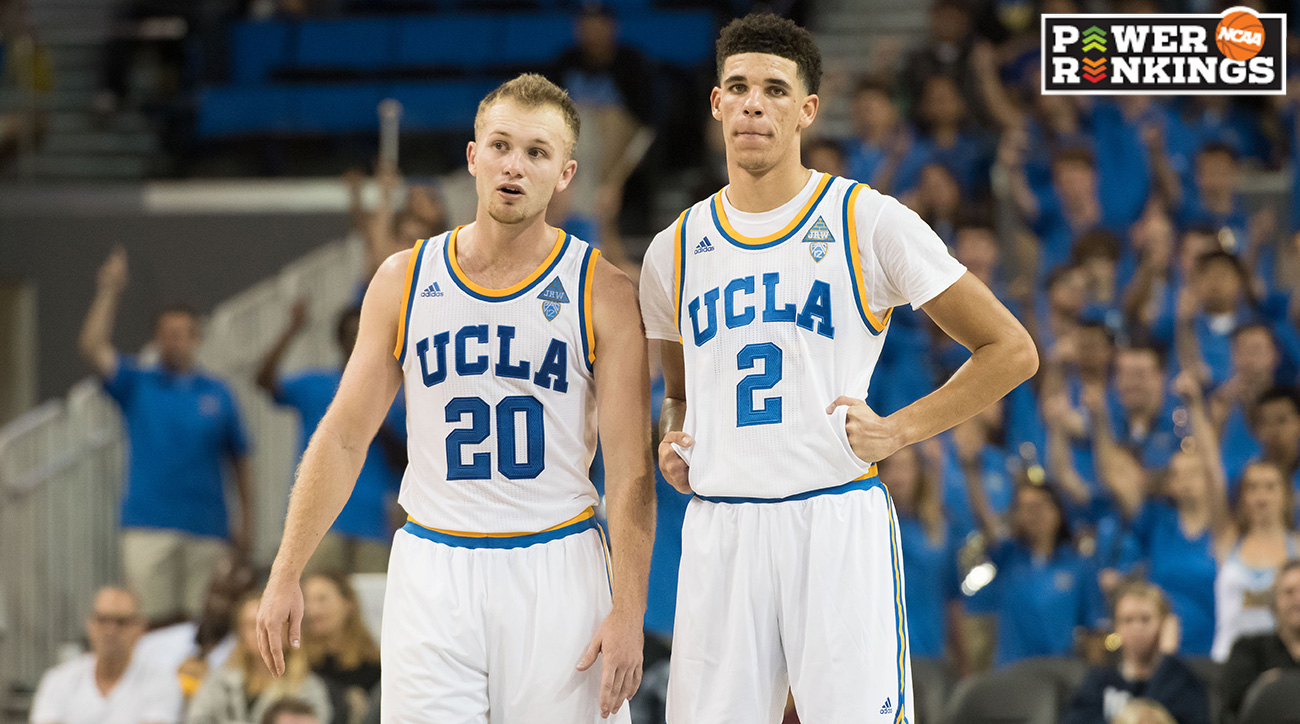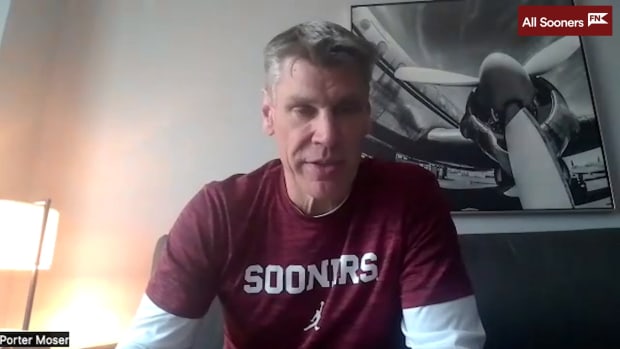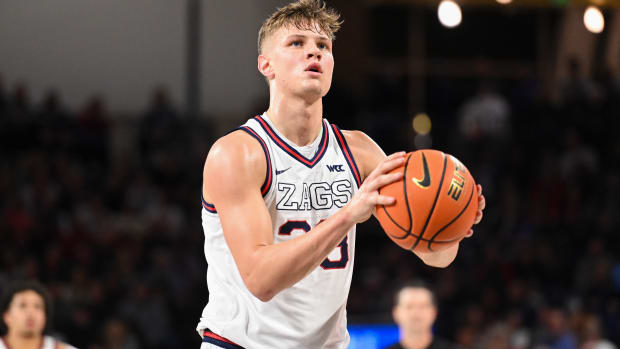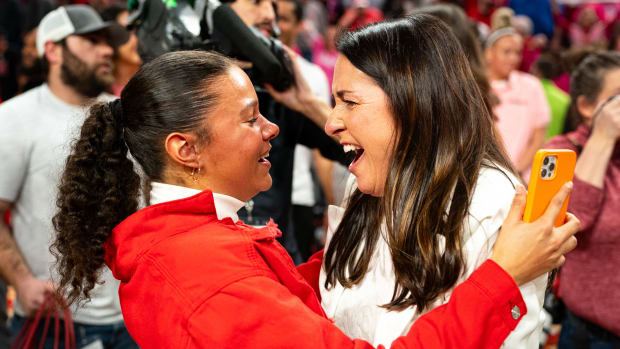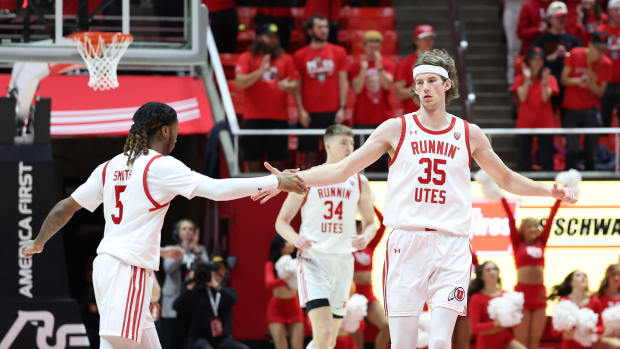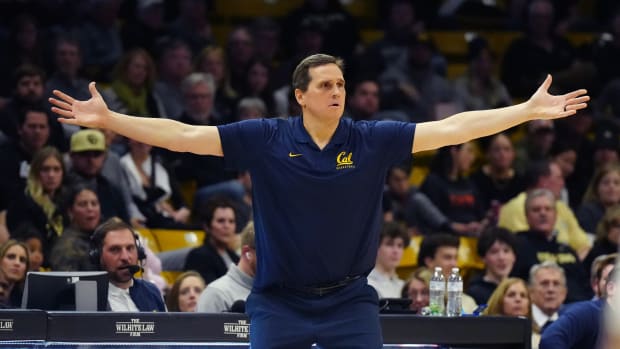Power Rankings: Undefeated UCLA continues its ascent
The Finals Week edition of the Power Rankings digs into the driving skills of Josh Hart, the Ish Wainwright Effect, a Thomas Bryant pick-and-roll breakthrough . . . and also puts 32 teams in a nice, numbered list:
1. Villanova Wildcats
PREVIOUS: 1
RECORD: 11-0
The NBA’s advanced player tracking keeps a stat that I wish were available for collegians: “Drives,” which are instances in the halfcourt when a player starts his dribble from at least 20 feet away from the basket, gets within 10 feet, and either shoots, gets fouled, assists or turns the ball over. I’d like proof that Josh Hart’s 37-point tour de force against Notre Dame on Dec. 10 was, in fact, the most efficient driving game of the season.Hart was nearly unstoppable in that game: According to my unofficial video charting, he had eight “Drives,” which generated eight layup attempts and 14 points—or 1.75 points per drive. You need not be an efficiency wonk to know that that’s excellent.I ended up watching more Hart tape after that, and—because he’s not much of a drive-to-assist guy—I charted every halfcourt instance from the past four games where he put the ball on the floor leading up to a shot attempt, drawing a foul or committing a turnover. These fell into the categories of “Drives to Score,” following the NBA definition, and “Pull-Ups to Score,” meaning anything that terminated outside of 10 feet.What emerged was a stark difference between the efficiency of his “Drives to Score” (good, at 1.045 points per) and “Pull-Ups to Score” (not good, at 0.583). When he settles for an off-dribble J rather than getting deep into the paint, his possessions lose a lot of value:Next up: 12/21 vs. American, 12/28 vs. DePaul, 12/31 at Creighton
2. UCLA Bruins
PREVIOUS: 6
RECORD: 11-0
ICYMI yesterday on SI.com, I devoted a column on Wednesday to the Bruins’ offensive transformation, including context on their historically good combination of pace and offensive quality, the massive impact that the addition of Lonzo Ball and a move away from ballscreen offense has had on guards Bryce Alford and Isaac Hamilton, and an update on the Ball assist-distribution wheel. Here’s that graphic, updated after Wednesday’s rout of UC Santa Barbara, in which Ball had seven more assists, to four different Bruins. He is sharing the wealth:Next up: 12/17 vs. Ohio State in Las Vegas, 12/21 vs. Western Michigan
3. Kansas Jayhawks
PREVIOUS: 3
RECORD: 9-1
For almost every team—even the ones that like to play inside-out—post-up scoring attempts tend to be less efficient than spot-up-based scoring attempts (which mean catches to shoot, or catches to face up and attack, generally from the perimeter). At Kansas, where they’ve typically had skilled post scorers, the value gap between the two possession types hasn’t been all that large over the previous four seasons . . . but in 2016–17, it’s huge. As the Jayhawks have shifted to a smallball starting lineup, they’re getting just 0.75 PPP on post-ups, and 1.10 PPP on spot-ups—a gap more than four times bigger than it was in ‘15–16.This gap could shrink as freshman giant Udoka Azubuike improves, or if Carlton Bragg (a decent post player) carves out a bigger role in the rotation, but if it doesn’t, it will behoove Kansas to get even more perimeter-oriented.Next up: 12/17 vs. Davidson in Kansas City, 12/22 at UNLV
4. Duke Blue Devils
PREVIOUS: 4
RECORD: 10-1
The Blue Devils do some really simple stuff—that works incredibly well—to create scoring opportunities for breakout sophomore star Luke Kennard. This season’s first Power Rankings highlighted their use of him rising up from one of the corners for handoffs out their A-set:Against Florida in last week’s Jimmy V Classic, Duke made multiple play calls for a two-high (as in, outside the three-point line), two-low (on the blocks) look with Kennard running off of baseline screens. What was noteworthy about this play is that Kennard would point and direct ball movement from his baseline spot, setting up two-pass actions that would lead to him scoring. Watch it unfold twice here:Next up: 12/19 vs. Tennessee State, 12/21 vs. Elon in Greensboro, N.C.
5. Indiana Hoosiers
PREVIOUS: 5
RECORD: 8-1
I remain committed to tracking the major event in the Hoosiers’ offense that is the 6' 10" Thomas Bryant using possessions as a pick-and-roll ball-handler.This began not in early season garbage time, but rather with 5:43 left in a 74–74 tie with Kansas in the season opener, when Bryant missed a pull-up three out of a spread ballscreen set (with his two-guard setting the screen):To the best of my knowledge, the second time Blackmon-ballscreening-for-Bryant was attempted was on a broken-down play against Liberty on Nov. 19—but Bryant double-dribbled. You don’t need to watch that one. The third attempt came against Fort Wayne on Nov. 22, with 6:02 left in the second half, but Bryant’s man wouldn’t come out beyond the arc, the screen was set near the free-throw line, and the Mastodons just halted it with a four-man wall:Against Southeast Missouri State on Dec. 4, the Bryant P&R ball-handler option finally generated points. Once again, it happened near the six-minute mark of the second half (it’s as if there’s a script calling for it at that stage), but it came out of a new action, with Bryant rising up from the left corner to receive a dribble-handoff into a 4–5 ballscreen. The spacing is correct here, the Hoosiers get a favorable switch of a tiny guard onto center De’Ron Davis, who makes a smart roll to the rim . . . and Bryant hits him for a bucket. Bravo, Thomas:(Screengrab source: BTN)Next up: 12/17 vs. Butler in Indianapolis, 12/19 vs. Delaware State
6. Baylor Bears
PREVIOUS: 7
RECORD: 9-0
What’s the key to beating Baylor? It might just be figuring out a way to get point forward and glue guy extraordinaire Ish Wainright off the floor. Using hooplens.com’s data, I isolated the Bears’ individual on/off efficiency margins from their six games against top-100 opponents: Oregon, Dunk City, VCU, Michigan State, Louisville and Xavier. And although Wainright’s box-score stats are often unremarkable, his role as a low-turnover creator and ball-mover clearly changes the game. Baylor’s offense has been +0.26 points per possession better with him on the floor, and Baylor has been +0.34 PPP better overall with him on the floor. None of his teammates’ margins are even close:Next up: 12/17 vs. Jackson State at Fort Hood, Texas, 12/18 vs. John Brown
7. Kentucky Wildcats
PREVIOUS: 2
RECORD: 9-1
A few things that Malik Monk’s advanced AAU stats (harvested from DraftExpress.com) suggested about him have held up in college, namely that he’s a high-usage scorer who finishes well around the rim. Where his offensive profile has changed between AAU and Kentucky is that he’s now a majority three-point shooter as well as a better three-point shooter . . . but that’s also led to his free throw rate cutting in half. He’s been effective for the Wildcats, but he is certainly slashing and gunning less than he did during his AAU days:Next up: 12/17 vs. North Carolina in Las Vegas, 12/21 at Louisville
8. North Carolina Tar Heels
PREVIOUS: 8
RECORD: 10-1
In the aforementioned UCLA column from yesterday, I introduced something called Club Roy—the group of eight teams that have, since the inception of advanced stats in 2001–02, finished in the top 20 in tempo and the top five in offensive efficiency. It’s Club Roy because five of the eight were coached by Roy Williams:For this season and last season, however, North Carolina has been very good but has also slowed down. It currently ranks 42nd in tempo and was 94th in 2015–16, but it’s been a formula that works with its current roster, where it’s leveraging its size—with big man Kennedy Meeks as the primary possession-user—rather than trying to speed up itself or its opponents.Next up: 12/17 vs. Kentucky in Las Vegas, 12/21 vs. Northern Iowa
9. Gonzaga Bulldogs
PREVIOUS: 9
RECORD: 10-0
One reason the Zags are undefeated and might stay that way for a while: They’ve done an excellent job of limiting opponents’ damage from beyond the arc, ranking fourth in defensive 3PT% and 34th in ratio of 3s allowed to overall field-goal attempts (3PA/FGA). Using kenpom.com data, I averaged the national rankings for those two categories, and only Toledo and Gonzaga have an average ranking better than 20th:Next up: 12/18 vs. Tennessee in Nashville, 12/21 vs. South Dakota
10. Creighton Bluejays
PREVIOUS: 10
RECORD: 10-0
Everyone’s early forecast of the best games in November and December included Indiana-Kansas, Kansas-Duke, UCLA-Kentucky, and Kentucky-North Carolina . . . but it’s looking like one few expected—Villanova at Creighton on Dec. 31—will be just as big, if not bigger. Both teams could/should be undefeated heading into that game, and it’ll be the biggest hurdle ‘Nova faces in going on an undefeated run into the second half of the season. Should the Bluejays win, they could climb to an even higher ranking than they ever hit during the Dougie McBuckets era, and the CenturyLink Center will earn even more of a rep as a scary road venue, as a veteran Wisconsin team looked completely out of sorts there in November.Next up: 12/17 vs. Oral Roberts, 12/20 vs. Arizona State
11. Louisville Cardinals
PREVIOUS: 14
RECORD: 9-1
I realize these rankings contribute to the perception that Kentucky > Louisville this season, but there is, in reality, very little gap between these two teams, and I would be surprised if Dec. 21’s rivalry game isn’t decided by 1–2 possessions. The Cardinals already have the better résumé of wins (over Wichita State and Purdue), and a reliably great defense, which ranks No. 1 in adjusted efficiency. They can win a game where they exploit Kentucky’s biggest defensive flaw—that it lacks rebounding support for freshman center Bam Adebayo, who himself doesn’t defensively board at the rate of a Towns or Davis—and limit Monk-and-Briscoe buckets in transition.Next up: 12/17 vs. Eastern Kentucky, 12/21 vs. Kentucky
12. Wisconsin Badgers
PREVIOUS: 17
RECORD: 10-2
Sophomore five-man Ethan Happ continues to force turnovers at a notably high rate for a frontcourt player. Last season, he ranked No. 1 nationally in steal rate* for players 6' 9" or taller, at 4.0%, according to kenpom.com, and this season Happ ranks second only behind Oklahoma’s Khadeem Lattin:(* Steal rate is defined as percentage of defensive possessions played in which you log a steal. Advanced, but simple.)Next up: 12/23 vs. Florida A&M, 12/27 vs. Rutgers
13. West Virginia Mountaineers
PREVIOUS: 25
RECORD: 8-1
West Virginia’s guards, of course, scoff at Ethan Happ’s steal rate: 6' 2" junior Jevon Carter leads all players in that category at 6.5%, and as a team the Mountaineers are forcing turnovers on a ridiculous 34.7% of possessions. That would blow away the analytics-era record if it holds up, but it’s bound to regress during conference play when opponents can actually bring the ball up against WVU’s press without wetting themselves. The single-game TO rates for opponents such as New Hampshire (43.5%!), Manhattan (45.9%!) and Western Carolina (45.2%!) are unlikely to be replicated in the Big 12.Next up: 12/17 vs. UMKC, 12/20 vs. Radford
14. Butler Bulldogs
PREVIOUS: 11
RECORD: 9-1
The biggest story of this weekend’s Crossroads Classic is not about the matchup between one-loss teams that appear in the Power Rankings: It’s the return of bulldog mascot Butler Blue III, who had the equivalent of doggie ACL surgery in October. His full rehab has been covered (in beautiful detail) by the school, but the signature moment was clearly the underwater treadmill:The Rankings will have analytics on the efficiency of Blue’s gait in the coming weeks.Next up: 12/17 vs. Indiana in Indianapolis, 12/21 vs. Vermont
15. Notre Dame Fighting Irish
PREVIOUS: 20
RECORD: 9-1
The Irish are the only team to move up after losing, but late breakdowns against Villanova aside, they look deserving of a spot in the top 16, and I would not be shocked if they finish in the top 4–5 of the loaded ACC. In most years, Bonzie Colson, whom we profiled on SI.com in November, would just be regarded as a fun anomaly, but there’s such a lack of dominant interior players in 2016–17 that he actually has a shot at being an All-America. The numbers are there already; the nation just has to acclimate to the idea that a 6' 5" guy can be the most effective power forward in the country.Next up: 12/17 vs. Purdue in Indianapolis, 12/19 vs. Colgate
16. USC Trojans
PREVIOUS: 31
RECORD: 9-0
The Trojans aren’t getting much hype yet, but their undefeated record is far from fraudulent. It includes a quality road win at Texas A&M and neutral-court wins over SMU and BYU—not necessarily NCAA tournament teams, but not cupcakes. And USC seems to have made defensive gains from last season, when it reached the NCAAs as a No. 8 seed, combining rim protection (led by the long Chimezie Metu) and foul-avoidance to jump into the national top 50 in efficiency. This could very well be a darkhorse team that chases second place in the Pac-12.Next up: 12/17 vs. Troy, 12/19 vs. Cornell
The Next 16
17. Virginia
18. Oregon
19. Arizona
20. Purdue
21. Xavier
22. South Carolina
23. St. Mary’s
24. Florida State
25. Florida
26. Cincinnati
27. Virginia Tech
28. Wichita State
29. Seton Hall
30. Minnesota
31. UT Arlington
32. Middle Tennessee
